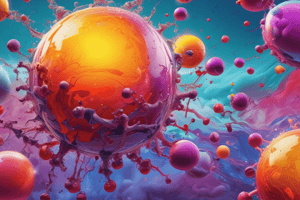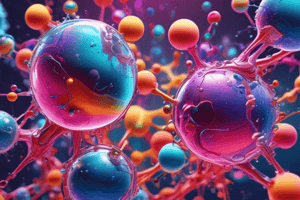Podcast
Questions and Answers
What is a distinguishing characteristic of a chemical change?
What is a distinguishing characteristic of a chemical change?
Which of the following best describes a solution?
Which of the following best describes a solution?
What type of bond involves the transfer of electrons?
What type of bond involves the transfer of electrons?
Which of the following compounds is correctly identified based on its elemental composition?
Which of the following compounds is correctly identified based on its elemental composition?
Signup and view all the answers
What does the formula for density (D = M/V) represent?
What does the formula for density (D = M/V) represent?
Signup and view all the answers
Study Notes
Chemical Change
- Involves an energy change (heat or temperature change).
- May produce a change in smell.
- Can often be reversed (undone).
- Results in the formation of a new substance.
- May exhibit a change in color.
Physical Change
- Can be reversed (undone).
- Does not create new substances.
- May involve a change in size.
Solutions
- Mixtures of multiple components, often indistinguishable.
- Example: Coke contains various substances that are not visually separable.
Chemical Mixtures
- Mixtures of components that are easily visible.
- Example: A chicken pizza shows separate components such as chicken, cheese, and bread.
Density
- Density (D) = Mass (M) / Volume (V).
Isotopes
- (No specific detail provided regarding isotopes).
Covalent Bonds
- Form between two nonmetals.
- Involve the sharing of electrons.
Ionic Bonds
- Occur between a metal and a nonmetal.
- Involve the transfer of electrons (metal loses, nonmetal gains).
Compounds
- Made from two or more different elements joined together.
- Examples: H₂O, HCl.
- Use prefixes (e.g., dioxide, trihydrogen) only when both elements are nonmetals; otherwise, use standard element names.
Formulas
- Represent elements and their bonds.
- Show electron sharing or transfer.
- Use dots to visually represent electrons involved in bonding.
Diatomic Molecules
- Seven elements naturally exist as diatomic molecules.
- Memorization trick: "Have No Fear Of Ice Cold Beer" (H₂, N₂, F₂, O₂, I₂, Cl₂, Br₂).
Studying That Suits You
Use AI to generate personalized quizzes and flashcards to suit your learning preferences.
Description
This quiz covers key concepts related to chemical and physical changes, including energy changes, properties of mixtures, and bonding types. Test your understanding of density, covalent and ionic bonds, and how these concepts apply to everyday substances. Perfect for students in chemistry classes.




